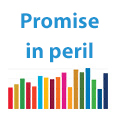Clean water and sanitation
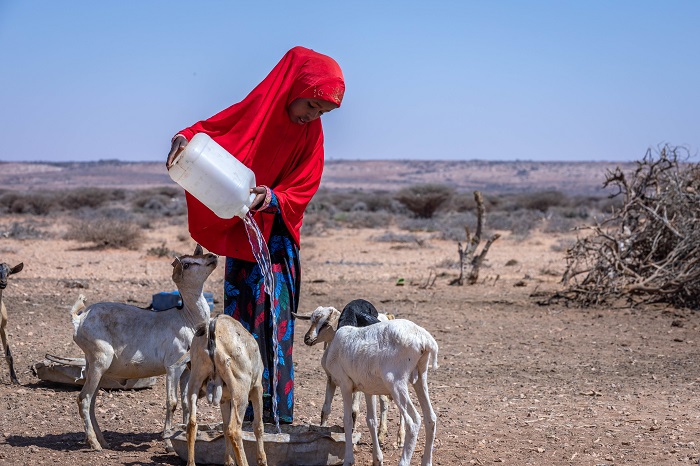
Fatuma pours water, obtained from a recently installed solar-powered borehole, for her family’s baby goats in drought-stricken Somalia.
© UNICEF/Mulugaeta Ayenecoordination and cooperation among all stakeholders, and adopting a more integrated and holistic approach to water management.
Access to drinking water, sanitation and hygiene improved significantly in rural areas, but stagnated or decreased in urban areas
Between 2015 and 2022, the proportion of the world’s population with access to safely managed drinking water services increased from 69 to 73 per cent; safely managed sanitation services increased from 49 to 57 per cent; and basic hygiene services increased from 67 to 75 per cent. This progress signifies an additional 687 million, 911 million and 637 million people gaining access to these essential services, respectively. Open defecation decreased from 715 million to 419 million during this period. However, in 2022, 2.2 billion people still lacked safely managed drinking water, including 703 million without a basic water service; 3.5 billion people lacked safely managed sanitation, including 1.5 billion without basic sanitation services; and 2 billion lacked a basic handwashing facility with soap and water at home, including 653 million with no handwashing facility at all. Sub-Saharan Africa is furthest behind. During this period, while the rural population saw improvements in access, the urban population’s access remained largely unchanged or decreased. To achieve universal coverage by 2030, the current rates of progress would need to increase by three to six times.
Global urban and rural population without safely managed drinking water, safely managed sanitation, and basic hygiene services, 2015/17–2022 (billions)
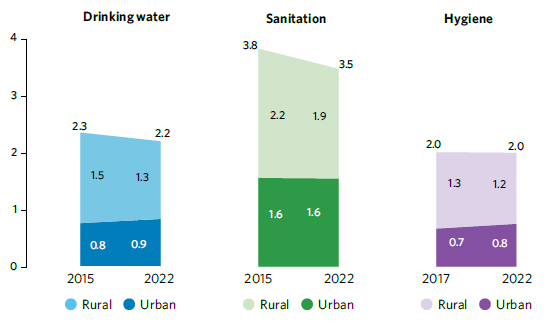
Water quality is improving in countries with robust monitoring, but there are still many unknowns
Progress towards the target of halving the proportion of untreated wastewater by 2030 is limited. Based on data from 140 countries and territories, about 58 per cent of household wastewater was safely treated in 2022. However, wastewater statistics are lacking in many countries and reporting is low, especially from industrial sources.
Data from 2017–2020 indicate that 60 per cent of assessed water bodies in 97 countries had good ambient water quality. Countries with robust monitoring systems showed positive trends: 44 per cent of countries reporting in both 2017 and 2020 were on track to improve water quality. However, a lack of data poses a risk to more than 3 billion people living in areas where the quality of freshwater is unknown. Agriculture and untreated wastewater are major threats to water quality, with nitrogen and phosphorus measurements frequently failing to meet targets. Efforts are needed to improve farming practices and wastewater treatment, especially in regions with high population growth.
Proportion of bodies of water with good ambient water quality, 2017–2020 (percentage)
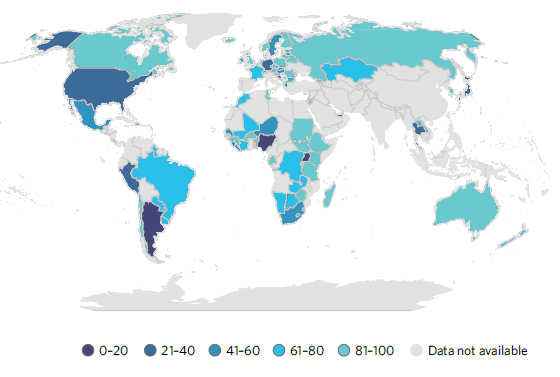
Water-use efficiency has improved, particularly in agriculture, but rising water stress in several areas is cause for concern
Although global water stress levels (the ratio of freshwater withdrawn to total renewable freshwater resources) remained at a safe level of 18.2 per cent in 2020, this masks substantial regional variations. Central and Southern Asia experience high water stress levels, exceeding 75 per cent, and Northern Africa faces critical water stress, surpassing 100 per cent. The region of Northern Africa and Western Asia has seen a concerning 18 per cent increase in water stress between 2015 and 2020. An estimated 2.4 billion people lived in water-stressed countries in 2020, of which almost 800 million lived in high and critically high water-stressed countries.
Improving water-use efficiency is one key to reducing water stress. Water-use efficiency worldwide rose 9 per cent, from $17.4/m3 in 2015 to $18.9/m3 in 2020. It ranges from below $3/m3 in economies that depend on agriculture to over $50/m3 in highly industrialized or service-based economies. The agriculture sector experienced the greatest increase in water-use efficiency (20 per cent) from 2015, compared with the industrial and service sectors (13 and 0.3 per cent, respectively). Improving water-use efficiency will require more efficient irrigation, better agricultural management, tackling leakages in distribution networks and optimizing industrial and energy cooling processes.
Water-use efficiency, 2015 and 2020 (United States dollars/m3)

Note: Oceania^ includes data from only Australia, New Zealand and Fiji.
Enhancing water management and transboundary cooperation is critical for bolstering resilience to crises
A lack of both cross-sector coordination over water and operational arrangements for transboundary water cooperation threatens the achievement of Sustainable Development Goals targets on climate, food, energy, health, life on land and below water, and peace. Although there has been global progress on integrated water resources management between 2017 and 2020, with the overall score increasing from 49 to 54 out of 100, it falls far short of meeting target 6.5 of implementing integrated water resources management at all levels by 2030. Encouragingly, 44 countries have nearly achieved the target and 22 countries have proved that real and rapid progress is possible, but urgent acceleration is needed in 107 countries. Out of 153 countries sharing transboundary rivers, lakes and aquifers, only 32 have 90 per cent or more of their transboundary waters covered by operational arrangements, suggesting that significant efforts are needed to ensure that all shared rivers, lakes and aquifers are covered by 2030. The world must accelerate all aspects of water management, together with transboundary cooperation, to increase its resilience to crises – including climate, health and poverty.
Integrated water-resources-management implementation progress, 2017–2020
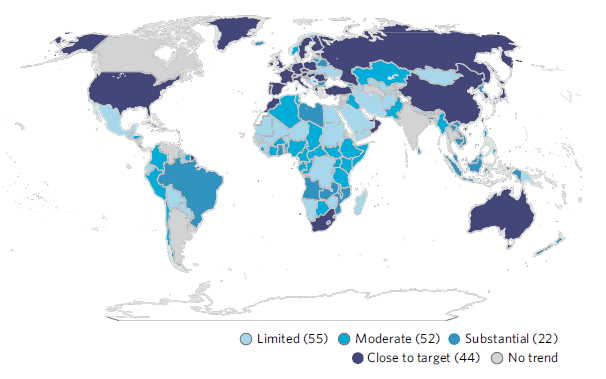
Note: Number of countries progress per level in parentheses.
Decline in official development assistance to water sector raises concerns
Official development assistance disbursements to the water sector decreased by 15 per cent between 2015 and 2021, from $9.6 billion to $8.1 billion. Total official development assistance commitments to the water sector have also fallen 12 per cent, from $11.2 billion in 2015 to $9.8 billion in 2021. Commitments peaked at $13.5 billion in 2017 and have decreased every year since. Sub-Saharan Africa received the largest share – 28 per cent or more of water-sector official development assistance disbursements every year since 2015 – but all SDG regions saw decreased disbursements from 2019 to 2021. Additionally, donor alignment with national water-sector plans remains low, with only 29 per cent of countries reporting high alignment in 2021.
As wetland ecosystems and species disappear, large-scale protection and restoration are imperative
Water-related ecosystems provide clean water, regulate floods and droughts and support biodiversity. But these ecosystems face numerous threats, including pollution, climate change and overexploitation. The extent of surface water bodies, such as lakes, rivers and reservoirs, are rapidly changing worldwide, with one in five river basins experiencing above-natural fluctuations in surface water over the past five years. Wetland ecosystems have suffered an alarming 85 per cent loss in the past three centuries, primarily from drainage and land conversion. Since 1970, a staggering 81 per cent of species dependent on inland wetlands have declined, surpassing declines in other biomes, and an increasing number are at risk of extinction. It is imperative to prioritize the protection and restoration of wetlands on a large scale.
